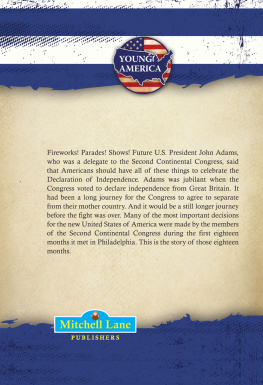First published 2009 by Ashgate Publishing
Published 2016 by Routledge
2 Park Square, Milton Park, Abingdon, Oxon OX14 4RN
711 Third Avenue, New York, NY 10017, USA
Routledge is an imprint of the Taylor & Francis Group, an informa business
Copyright Ellwood P. Hinman IV, Thomas E. Jahn and James G. Jinnette 2009
Ellwood P. Hinman IV, Thomas E. Jahn and James G. Jinnette have asserted their right under the Copyright, Designs and Patents Act, 1988, to be identified as the authors of this work.
All rights reserved. No part of this book may be reprinted or reproduced or utilised in any form or by any electronic, mechanical, or other means, now known or hereafter invented, including photocopying and recording, or in any information storage or retrieval system, without permission in writing from the publishers.
Notice:
Product or corporate names may be trademarks or registered trademarks, and are used only for identification and explanation without intent to infringe.
British Library Cataloguing in Publication Data
Hinman, Ellwood P.
AirLandBattle21: transformational concepts for integrating twenty-first century air and ground forces
1. Unified operations (Military science) 2. Air power - United States 3. Air warfare - United States 4. Military doctrine - United States
I. Title II. Jahn, Thomas E. III. Jinnette, James G.
355.460973
Library of Congress Cataloging-in-Publication Data
Hinman, Ellwood P., 1966-
AirLandBattle21: transformational concepts for integrating twenty-first century air and ground forces / by Ellwood P. Hinman, Thomas E. Jahn, and James G. Jinnette.
p. cm.
Includes bibliographical references and index.
ISBN 978-0-7546-7634-8
1. Unified operations (Military science) 2. Air power--United States. 3. Air warfare--United States. 4. Military doctrine--United States. I. Jahn, Thomas E. II. Jinnette, James G. III. Title. IV. Title: Air Land Battle 21, transformational concepts for integrating 21st century air and ground forces. V. Title: Transformational concepts for integrating twenty-first century air and ground forces.
U260.H55 2008
355.460973--dc22
2008038306
ISBN 13: 978-0-7546-7634-8 (hbk)
Ellwood P. (Skip) Hinman IV, Thomas E. (Tom) Jahn, and James G. (J.J.) Jinnette are U.S. Air Force pilots with over 9,500 combined hours flying eight different fighter, airlift, and training aircraft. All three officers graduated from the Air Force Academy and have earned seven masters degrees throughout their careers. They have accumulated a total of over 56 years of military service in numerous assignments from the squadron level to the Office of the Secretary of Defense, including tours commanding at the squadron level, developing strategy on a numbered Air Force staff, writing doctrine at the Air Force Doctrine Center, and teaching at Air University. They have collectively participated in several contingency and combat operations to include Desert Storm, Provide Comfort, Southern Watch, Allied Force, Phoenix Scorpion, Enduring Freedom, and Iraqi Freedom.
Chapter 1
Laying the Foundation
New conditions require, for solutionand new weapons require, for maximum applicationnew and imaginative methods. Wars are never won in the past.
General Douglas MacArthur
The changed strategic landscape of the Twenty-first century has driven the Department of Defense (DoD) to direct transformation in the U.S. military. In essence, this mandate requires a shift from legacy technologies and Cold War organizations to more flexible, adaptable capabilities and constructs effective across the spectrum of conflict. At its core, this transformation represents a revolution in military affairs (RMA). Most define an RMA as the confluence of new technologies, new organizations, and new ideas. Each of the Services has embarked on aggressive plans that feature many transformational technologies accompanied by new organizational constructs. The U.S. Army, for example, has shifted to modular forces based on the brigade combat team (BCT) and new technologies such as the Stryker infantry vehicle and many others incorporated into the Future Combat System (FCS).
For the revolution in military affairs to be complete, though, the same transformation must take place in the area of ideas. These new concepts must bridge the ongoing changes within the separate branches and integrate the developing Service-specific technological capabilities into a seamless whole. More specifically, the need exists for a coherent set of transformational concepts that fully integrate Twenty-first century American airpower with the Armys new brigade combat team. The purpose of this study, then, is to offer innovative thought in the areas of counterland, counterair, strategic attack, and tactical airlift that will merge on-going transformational efforts in the Air Force and Army into a single, potent fighting force. In the last century, the threat of war with the Soviet Union in central Europe led to a similar transformation after the U.S. debacle in Vietnam that culminated with the development of an operational concept for air and ground forces labeled AirLand Battle. AirLand Battle fell away with the Berlin Wall and a comprehensive approach has yet to replace it. The ideas developed in this book will form the baseline for a novel military strategy toward a new AirLand Battle construct for the transformed context of the Twenty-first century.
The Need for Transformational Ideas
The 2006 National Security Strategy observed that the major institutions of American national security were designed in a different era to meet different challenges. They must be transformed and proclaimed that the United States must transform Americas national security institutions to meet the challenges and opportunities of the 21st Century (National Security Strategy 2006, 1, 43). While former Defense Secretary Donald Rumsfeld initially led the DoD transformation, his successor, Secretary Robert Gates clearly stated during the November 2006 Senate confirmation process his intent to stay the transformational course: If confirmed, I will build upon the Presidents commitment to transform our forces to better fit the 21st century. Transformation holds the promise to ensure that our military forces are more agile and lethal when confronting the enemies of this new century (Gates November 2006, 11). In his initial message to DoD personnel, the Secretary Gates formalized and reaffirmed his position:
It is important that we carry forward the process of what has been referred to as defense transformation. President Bush made it a priority at the beginning of his administration to help our military become more agile, more lethal, and more expeditionary. Much has been accomplished; much remains to be done. This task remains a necessity and a priority today (Gates December 2006).












